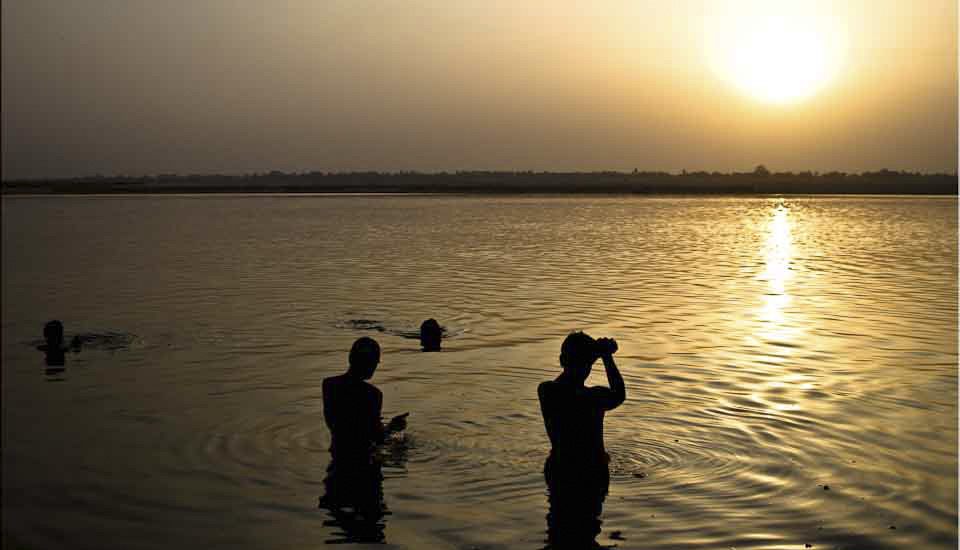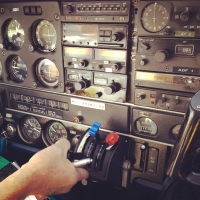.jpg)
Three Tambul Men – Western Highlands
With their spears, face paint, and tall, elaborate wigs, these men would be a formidable sight if you came across them accidentally in the jungle!
It was a bit of an anti-climax …
After several days in the Papua New Guinea Highlands, mingling with and photographing the myriad of fascinating and colourful tribes who had come to participate in the annual Mt Hagen Cultural Show (see: Mt Hagen) and the smaller, more intimate Paiya Show (see: Paiya Village), we were meant to be on our way to the beautiful Milne Bay. But, after we had checked out of our hotel rooms, settled our bills, and stowed our baggage on the minibus for the airport, the phone call came: our flight had been cancelled.
All the Air Niugini pilots were on strike in solidarity with eight pilots who had been fired the year before for being part of a nation-wide protest against Prime Minister O’Neill, who was facing fraud allegations at the time.
That is the kind of place Papua New Guinea is: still wild and tribal, where getting from A to B can be difficult. Unless you have a lot of time, a machete, and a good sense of direction, flying is the only way to get from Mt Hagen back to the capitol Port Moresby. And, in this rugged terrain, flights are often delayed or cancelled on account of bad weather, poor visibility, or due to mechanical or staffing issues.
So, my travel companions, photographer Karl Grobl from Jim Cline Photo Tours, and I, had a day in Mt Hagen we hadn’t been planning on.
But, the locals demonstrated their resilience and flexibility. Our hotel checked us back into the rooms we had just vacated, the mini-bus took us to the local market instead of the airport (see: Mt Hagen Market), and our local contact, Pym from Paiya Tours, went to work finding us a replacement activity.
And that is how I ended up back in Paiya Village, where some elderly men from Tambul had been ferried in to be our portraiture subjects.
The Tambul-Nebilyer District is in the southwest corner of the Western Highlands Province. The population is supported by subsistence farming in the fertile lands at the base Mt. Giluwe, the country’s second highest mountain. There are several distinctive tribes in the district, collectively numbering just over 75,000 people; they are all known for their impressive headdresses and their songs that resemble war cries.
Although the distance between Mt Hagen and Tambul is less than 50 kilometres (30 miles), the estimated driving time is over an hour and a half. This gives you an idea of the sort of terrain we are talking about!
Come meet some elders:
.jpg)
Hills from the Bus
The jungle-clad hills of the Western Highlands extend high into the clouds; the rich soils are a boon to the many small-holder (subsistence) farmers.
.jpg)
St Andrew’s Cross Spider – Argiope Magnifica
Jungle is all around, …

Man with a Machete
… and only constant vigilance keeps it at bay.

Old Uncle
I met this Paiya Village elder several times; he was always a delight to photograph.

Tambul Man Face-Painting
When we got into the village clearings, three elderly Tambul men were already starting to prepare as if they were going to battle, or to perform at a sing-sing (cultural festival).

Black Base Paint
Even the unfinished face paint is quite ominous – which is its intention! Although these costumes are now mostly used for dance performances, they were originally applied before inter-tribal raids or wars.

Tambul Armbands
Feathers, shells, and greenery collected from the surrounding jungle, are typical costume elements.

Tambul Man Fixing his Headdress
Headdresses take a variety of forms in the Western Highlands: like the Hela Wigmen from further west, these men sport fabulous wigs of fur and hair, built onto bamboo frames, and decorated with shells, greenery, and feathers.

Tambul Skirt
The skirts or long loin cloths are fashioned from fibres, using the same looping technique that goes into making colourful string bilum bags.

Concentration

Tambul Man
We are a long way from the ocean: the mother of pearl wig decorations and the shell necklaces and chest plates are prized and valuable items in these mountains.

A Betel Smile and Facial Tattoos
Technically banned, chewing areca nut and betel leaf is endemic in the country. You see the red-stained mouths and teeth everywhere.

Tambul Man in Face Paint
Tambul-Nebilyer District is at the corner of the Western Highlands, bordering Enga and Southern Highland Provinces. So, Tambul dress, face and body paint, and traditions, borrow from these neighbours.

Face Paint and Feathers
Parrot bodies and bird of paradise feathers are such an essential element in tribal adornment, I was always amazed the birds are not more endangered!

Tambul Man in the Jungle
The kina moka shell shields these men are wearing as chest plates are highly valued symbols of wealth and power.

Tambul Man with Spears
Tall bird of paradise feathers give the men extra height, and the bamboo spears are finely honed.

Local Papuan Man
The local villagers loved watching us watching them.

Tambul Man in Face Paint
I was hot just looking at the fur in those wig-hats! The painted wooden shield behind this man belongs to Paiya Village people – not Tambul.

Corrugated House
Tourism has helped develop some of these remote areas: simple corrugated iron houses with electricity are an improvement on the dark, grass huts with mud floors that people were living in a scant generation ago.

Taro Plants

Sweet Potato
As we left the village, I once again marvelled at the lush and tidy vegetable gardens.
It’s a wild and rugged place. One that has bred some strong and resilient people. The men we met were lovely – but theirs was not a look I’d want to challenge in the depths of this jungle! In the current climate, travel in this area has become even more fraught. At the time of writing, only 1.7% of the Papua New Guinea population had been vaccinated against Covid-19, and community transmission of the disease was still spiralling.
 Some of this is due to the difficulty of providing health information and services in this difficult terrain.
Some of this is due to the difficulty of providing health information and services in this difficult terrain.
But more is due to the strength of tribal traditions and beliefs, and a historically justified distrust of outsiders (see: The Conversation).
It is hard to know how to bridge this gap between worlds: tribal resilience and relative isolation may be no match for modern viruses.
Pictures: 21August2017

























.png)

